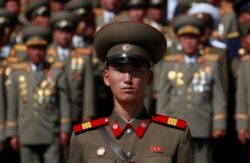by Charles Knight, 19 February 2019. A version of this article appeared in The National Interest on 19 February 2019. This revised version was published on the PDA website on 3 February 2022.
During meetings in late 2017 with nearly two dozen regional security specialists in Northeast Asia, I asked whether North Korea was a de facto nuclear-weapon state. Their answer almost always was, “Of course!” Then, these interlocutors sometimes volunteered the advice that it would be wise for the United States to adapt its regional policy according to the new reality.
 Those conversations came to mind as I read Robert E. Kelly’s recent op-ed that argues maintaining the status quo with North Korea is “better than a bad deal.” Kelly claims that “the world can learn to adjust to a nuclearized North Korea.” I agree while noting that many countries in Northeast Asia have been making that adjustment for years now. It is no longer in the U.S. national interest to pursue policies premised on denying North Korea’s status as a de facto nuclear power.
Those conversations came to mind as I read Robert E. Kelly’s recent op-ed that argues maintaining the status quo with North Korea is “better than a bad deal.” Kelly claims that “the world can learn to adjust to a nuclearized North Korea.” I agree while noting that many countries in Northeast Asia have been making that adjustment for years now. It is no longer in the U.S. national interest to pursue policies premised on denying North Korea’s status as a de facto nuclear power.
Kelly writes: “North Korea will almost certainly insist on keeping most of its warheads.” Indeed, the notion is still prevalent in Washington that North Korea will agree to disarm unilaterally. However, North Korea has paid a dear price to obtain nuclear weaponry. Therefore, there is almost no chance it will agree to unilateral disarmament.
U.S. nuclear capability is already enormously superior to North Korea’s minimum deterrent. North Korea surely understands that. Therefore, there is reasonable assurance that the deterrence of North Korea will hold firm for decades to come.
Nevertheless, the United States, citing the threat of North Korean nukes, intends to enhance its northeast Asian nuclear and anti-missile posture. In turn, the North will likely build more bombs and missiles. As a result, the chance to limit their nuclear program in negotiations will eventually be lost.
Kelly concludes the article, saying, “Slow-but-steady, reciprocal, and verifiable concessions is still the best way forward.” I concur, but I propose an edit to his diplomatic guidance, thus: “Slow-but-steady, reciprocal, and verifiable steps toward a mutually-acceptable political future for Korea — including relevant disarmament.”
What is the essential and significant difference in my re-write? The insertion of the phrase “steps toward a mutually-acceptable political future” is the key. I was introduced to this construction by the paper A Theory of Engagement with North Korea authored by Christopher C. Lawrence when he was a post-doc fellow at Harvard’s Kennedy School.
In his paper, Lawrence seeks to move the discourse from one of transactional diplomacy with its talk of carrots and sticks and concessions to one of relational diplomacy wherein the first task is to discover and establish a mutually-acceptable and shared political goal. From there, the parties negotiate particular steps (especially ones that involve costly physical commitments) by which the parties move slowly and steadily toward the goal. The mutuality of the goal provides the incentive to cooperate. This is a more productive approach to diplomacy, especially in cases where parties must overcome low levels of trust and a long history of conflict.
Robert Kelly’s preferred alternative to war or a bad deal is the status quo which he describes as “containing and deterring, sanctioning and isolating North Korea.” Yes, this might be a better option than starting a counter-proliferation war in which millions are likely to die. However, the status quo is a failed approach to Korean conflict and tension; a failed policy that is at least partially responsible for North Korea becoming a small but real nuclear power.
Rather than continue to isolate North Korea, the new realities require America to bring nuclear North Korea into as close a relationship as possible—so that there are opportunities to influence the North in regards to responsibly and safely managing its nuclear weaponry. It is hard to imagine such trust between North Korea and the United States at this time, but the United States can encourage China to play a role in persuading North Korea. Chinese and American interests align very closely regarding nuclear safety and restraint.
This is not the place to explore the fifty ways to build a constructive relationship with the North. I will, instead, mention that one open way that sits in plain view. Our ally, the Republic of Korea, has actively built a better relationship with the North during the last year. The Panmunjeom Declaration of 2018 set out in general terms the aspirations of a shared North-South Korean mutually acceptable political future.
Reverting to the status quo of isolating the North is a remarkably uncreative response to the security dilemmas of the moment. Instead, the United States will strengthen its Korean alliance while opening many paths to an acceptable political future for Korea by fully supporting its ally in building out the aspirations for Korean peace found in the Panmunjom declaration.
~~
For a detailed description of how relational diplomacy can be employed to achieve a safe and effective conventional forces drawdown on the Korean Peninsula as part of a Korean peace process see Charles Knight, A Path to Reductions of Conventional Forces on the Korean Peninsula. ➪ PDF.
